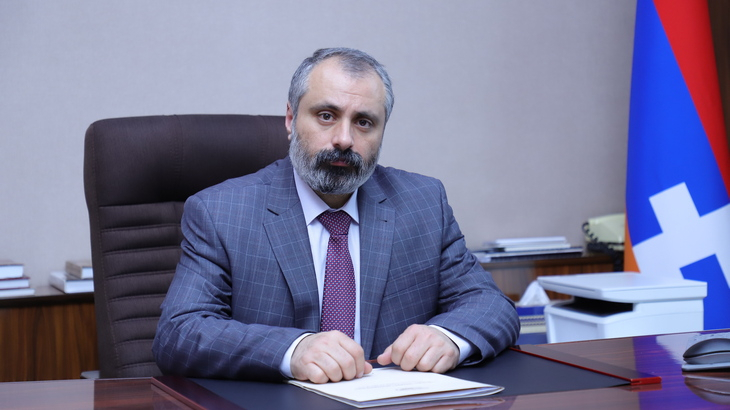STEPANAKERT (Realist English). Doctor of Historical Sciences, Chairman of the Conservative Party of Artsakh David Babayan answered the questions of Realist English.
What are the reasons for the massacre of Armenians in Shusha committed by the Turkish-Tatar pogromists?
David Babayan: What happened in Shushi at the end of March 1920 is one of the bloodiest events in the history of Artsakh, of the Armenian people, and of the Caucasus as a whole. One of the most beautiful and large cities of the Caucasus, the capital of Artsakh, was destroyed. Shushi had been one of the nodal cultural, economic, and political centers of the region.
The destruction of the city and the genocide of the Armenian population of Shushi was carried out by Azerbaijan, Turkey and thugs from neighboring regions who were in their service. The same thing happened, as you know, in 2020.
The goals of Azerbaijan and Turkey in 1920 were very clear. Naturally, the most important imperative of theirs was the destruction of Artsakh as one of the foundations of the Armenian statehood. Without Artsakh, the Armenian statehood and the Armenian people would be doomed to destruction. It was only a matter of time. Naturally, the destruction of Armenia and the Armenian people would create a completely new situation in the region, after that the entire Transcaucasia would have become Turkish – with all the consequences that follow from this. Among which one can note the deadly threat to Russia, Iran, eventually Europe, China, etc. Well, in order to destroy Artsakh, it was necessary to destroy its political, spiritual and economic center – Shushi.
I must say that one of the reasons for the vitality of Artsakh was that there were no large cities here for many centuries. The only exception was Tigranakert-Artsakh, which existed from the Ist century BC to the XIIIth-XIVth centuries AD. However, the role and place of Tigranakert in the history and life of Artsakh was somewhat different. The heyday of the city came mainly at a time when there was a unified Armenian statehood. Yes, it was one of the major cities of such a large state as Armenia was. Even its loss and destruction did not mean the destruction of the country or one of its parts – Artsakh. It was a planet in the political, economic, cultural and other “solar” system of the Armenian statehood.
Shushi had a completely different meaning. Since the XVIIIth century, Shushi had become the political, cultural, economic, spiritual center of the whole of Karabakh (Artsakh, part of Syunik, Utica), the “sun” in the “solar system” of Artsakh, one of the largest Armenian cities of that time, then surpassing Yerevan in population. It should be noted here that Shushi was founded by the Armenian meliks of Karabakh to become the future capital of Armenia. In addition, by 1920, the Armenian people lost most of their historical homeland as a result of the genocide of 1915.
It is clear that the destruction of Shushi could lead to irreversible consequences for Artsakh, its destruction, after which, as has been already noted, there would be a catastrophe for Armenia.
Yes, after the destruction of Shushi, Artsakh still survived. But it can be assumed with all confidence that if the Shushi catastrophe had not happened, then perhaps Karabakh would not have been part of Soviet Azerbaijan, created just one and a half or two years prior to Turkey’s implementation of its geopolitical pan-Turkist goals. The destruction of Shushi dealt a severe blow to Artsakh. The culture and intelligentsia of Artsakh were beheaded. Naturally, these “wounds” have sufficiently weakened Artsakh, the pain from which has forever remained in the hearts not only of the people of Artsakh, but also of the entire patriotically-minded Armenians.
How many Armenians suffered during that period?
David Babayan: This question is quite rhetorical. About 50 thousand people became direct victims of the tragedy, i.e. the entire Armenian population of Shushi, whose share exceeded 90% of the total population of the city. About half died, the rest were scattered around the world. By the way, the Shushi people who escaped the genocide became one of the main components that later formed the new capital of Artsakh – Stepanakert.
But the victims, or rather, the casualties, of course, are much more. This, as already noted, is all the patriotic Armenians in all corners of the world. For them, the destruction of Shushi is comparable with the loss of Jerusalem for the Jews, Constantinople for the Orthodox Christians. Armenians feel the same way about the medieval capital of Armenia – Ani.
Why did history repeat itself a century later? What lessons should be learned from it?
David Babayan: History often repeats itself due to poor or weak knowledge of history, both your own and the history of countries and peoples, on the relationship with which the fate and future of your people and state, i.e. your own history, depends.
But knowledge of history is not just a body of knowledge. It is necessary not only to know, but also to understand history. And this requires knowledge, experience and an appropriate system of values, i.e. professionalism and patriotism.
If any of these components degrades, then history will repeat itself, naturally, leading to even more terrible consequences.


















